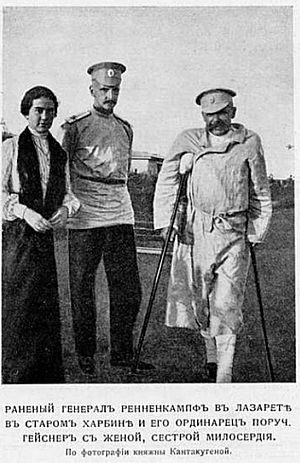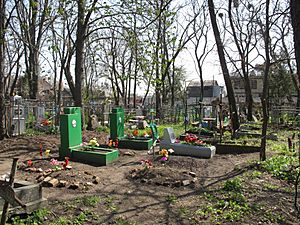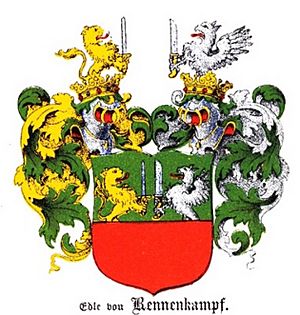Paul von Rennenkampf facts for kids
Quick facts for kids
Edler
Paul von Rennenkampf
|
|
|---|---|
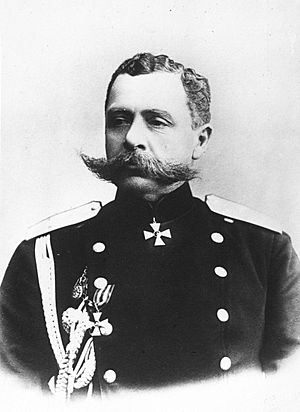
Rennenkampf in 1910
|
|
| Commander of the Vilna Military District | |
| In office 20 January [O.S. 7] 1913 – 19 July [O.S. 6] 1914 |
|
| Monarch | Nicholas II |
| Preceded by | Fyodor Martson |
| Succeeded by | Position abolished |
| Personal details | |
| Born | 29 April [O.S. 17] 1854 Konofer Manor, Konofer, Kreis Hapsal, Governorate of Estonia, Russian Empire (in present-day Konuvere, Rapla County, Estonia) |
| Died | 1 April 1918 (aged 63) Taganrog, Russian SFSR |
| Resting place | Taganrog Old Cemetery |
| Nationality | Baltic German |
| Military service | |
| Allegiance | |
| Branch/service | |
| Years of service | 1870–1915 |
| Rank | |
| Commands | 36th Akhtyrka Dragoon Regiment 1st Separate Cavalry Brigade Transbaikal Cossack Army 7th Siberian Army Corps 3rd Siberian Army Corps 3rd Army Corps Vilna Military District (1913–1914) 1st Army |
| Battles/wars | Boxer Rebellion
|
Paul Georg Edler von Rennenkampf (Russian: Па́вел Ка́рлович Ренненка́мпф, tr. Pavel Karlovich Rennenkampf, IPA: [ˈpavʲɪl ˈkarləvʲɪtɕ ˌrʲenʲːɪnˈkampf]; 29 April [O.S. 17 April] 1854 – 1 April 1918) was a Baltic German nobleman, statesman and general of the Imperial Russian Army who commanded the 1st Army in the invasion of East Prussia during the initial stage of the Eastern front of World War I. He also served as the last commander of the Vilna Military District.
Rennenkampf gained a reputation as an effective cavalry commander during the Boxer Rebellion and the Russo-Japanese War. Following service in the latter, he led the detachment that suppressed the Chita Republic during the 1905 Russian Revolution. This earned him further promotion, and by the outbreak of World War I Rennenkampf was commander of the Vilna Military District, whose forces were used to form the 1st Army under his command.
He led the 1st Army in the invasion of East Prussia and won an early victory at Gumbinnen in late August 1914, but was relieved of command after defeats at Tannenberg, the Masurian Lakes and Łódź, although he was later proved innocent for the mistakes made in the Battle at Łódź by an official inquiry into his actions. Rennenkampf was shot by the Bolsheviks in Taganrog during the Red Terror in 1918.
Contents
Early life and education
Paul Georg Edler von Rennenkampff was born on 29 April 1854 in the manor of Konofer (now Konuvere, Märjamaa parish, Estonia) in the then Governorate of Estonia; one of eight children of Captain Karl Gustav Edler von Rennenkampff and Anna Gabriele Ingeborg Freiin von Stackelberg, he came from the Konofer-Tuttomäggi-Sastama branch of the Baltic German Rennenkampff family and was of Lutheran faith. His paternal ancestors were of Westphalian origin, originating in Osnabrück. On his mother's side was the Stackelberg family, whose common ancestor was Carl Adam von Stackelberg, a Swedish cavalry officer and participant in The Great Northern War; he thus remained a fifth cousin of the Russo-Japanese War general Georg von Stackelberg.
Career
From late August to late November 1884, he was an over-officer of the 14th Army Corps, specialising in instruction. In late September 1886, he was the chief of staff of the Warsaw Military District, serving under General and later Field Marshal Count Gurko.
In early 1888, he was appointed to the Kazan Military District. Rennenkampf subsequently became the senior adjutant to the headquarters of the Don Cossacks. In late October 1889, he was appointed headquarters officer for special assignment at the 2nd Army Corps headquarters. In late March 1890, he was appointed the chief of staff of the Osowiec Fortress in Russian Poland. The same year he was promoted to colonel, after which he served in several different regiments until late November 1899, when he was appointed chief of staff of the Transbaikal region, and was promoted to major general.
From 1900 to 1901, Rennenkampf participated in the suppression of the Boxer Rebellion in China. He distinguished himself with extreme success during the campaign, receiving both the 4th and 3rd classes of the Order of St. George for military distinction.
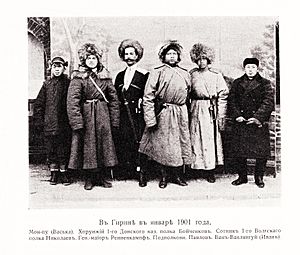
In February 1904, after the outbreak of the Russo-Japanese War, Rennenkampf was appointed commander of the Trans-Baikal Cossack Division. In June, he was promoted to lieutenant-general in recognition of his military distinction.
In the Battle of Mukden, Rennenkampf again distinguished himself commanding the Tsinghechensky detachment, which was stationed at the left flank of the 1st Manchurian Army led by General Nikolai Linevich. During the battle, he showed great persistence, which, combined with other reinforcements, was able to repulse Field Marshal Kawamura's offensive.
After the war, Rennenkampf commanded numerous army corps, including the 7th Siberian Army Corps, the 3rd Siberian Army Corps and the 3rd Army Corps.
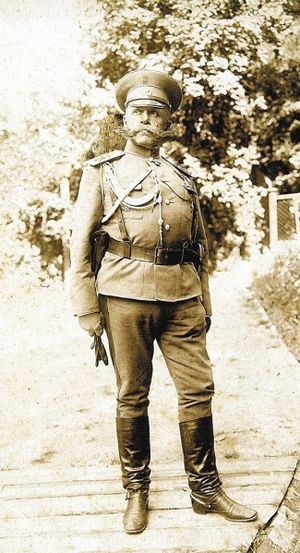
In late December 1910, he was promoted to General of the Cavalry, then promoted to General-Adjutant in 1912. A further promotion to commander-in-chief of all troops within the Vilna Military District followed in mid-January 1913.
World War I
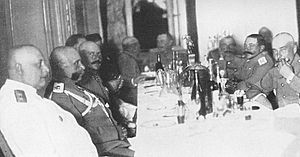
In the beginning of the First World War, Rennenkampf was appointed commander of the 1st Army of the Northwestern Front, under commander-in-chief General Yakov Zhilinsky. On 7 August 1914, Rennenkampf and his troops entered East Prussia from the east. While retreating upon orders from the defending 8th Army commander, General Maximilian von Prittwitz, a gap formed between the Russian armies; exploiting this, the Imperial German 1st Division, commanded by General Hermann von François, counterattacked at the Battle of Stallupönen, initiating the Eastern Front of the war. Although it was a victory for the Germans, Russian artillery bombardment halted the German offensive, causing François to withdraw to the town of Gumbinnen.
Rennenkampf continued his advance, defeating the 8th Army under the Prittwitz's command at the Battle of Gumbinnen. But due to a later incorrect assessment made by Zhilinsky, the victory at Gumbinnen did not develop. After the battle, Rennenkampf was ordered by Zhilinsky to launch an offensive against the heart of East Prussia, Königsberg, but his army did not link up with Samsonov's 2nd Army due to a mistake made by Zhilinsky. As a result, the German 8th Army under the new commander, General (later field marshal) Paul von Hindenburg, charged through the gap, then encircled and nearly wiped out the 2nd Army near Allenstein (the Battle of Tannenberg). When the desperate Samsonov sent his appeals for help, instead of immediately replying and heading south to aid Samsonov, Rennenkampf almost completely ignored the appeal. When he finally began to head south, he and his men started too late and proceeded more slowly than they should have, contributing to the defeat of the 2nd Army. After the battle, Samsonov, fearing being held responsible for the defeat, took his own life.
After the 2nd Army's annihilation at the Battle of Tannenberg, Rennenkampf's army took over all the defenses along the Deyma, Lava and the Masurian Lakeland. On 7 September, the First Battle of the Masurian Lakes began, as the Germans attacked the left flank of the 1st Army with a powerful detachment. Zhilinsky broke his promise to provide Rennenkampf with reinforcements from other formations; as a result, the 1st Army had to retreat hurriedly. The 2nd Army Corps, led by General Vladimir Slyusarenko, resisted desperately, as did Rennenkampf himself, who transferred all the cavalrymen, reserves, and troops from the right to left flank of the 20th Army Corps in order to avoid encirclement by Hindenburg. By 15 September, he skillfully withdrew his men from encirclement and withdrew behind the Neman, saving all the remaining troops he had. After this failure, despite his best efforts to blame Rennenkampf for the defeat, Zhilinsky was dismissed and was replaced by the General Nikolai Ruzsky.
In mid-November at Łódź, due to the indecisiveness and mistakes made by Ruzsky, the 1st Army was unable to prevent the XXV Reserve Corps of General Reinhard von Scheffer-Boyadel from escaping out of the encircling movement, causing the front to retreat. A sharp conflict then broke out between the two men. After the incident, Rennenkampf was relieved from his position. His acts during the battle became the subject of a special commission under General Peter von Baranoff; he was even considered being tried for treason, due to his ethnic background. He was then dismissed in early October 1915 "for domestic reasons with a uniform and pension".
After that, he stayed in Petrograd, living in retirement with his wife Vera until the Bolshevik coup. However, his retirement was extremely unsettling, as he was falsely accused of being a traitor, and all across Russia, on streets and in public places, people insulted him for his actions.
October Revolution and death
Rennenkampf was arrested after the October Revolution and, like many other tsarist officials, was imprisoned in the Peter and Paul Fortress. He was released shortly afterwards due to deteriorating health. After that, he, along with several other tsarist generals, went south to Taganrog, his wife's birthplace, and lived under the protection of a merchant named Smokovnikov.
After the Red Army took over the city, Rennenkampf disappeared, disguised as a Greek subject named Mandusakis, but was tracked down by the Red Army and identified, after which he was brought to the headquarters of the Bolsheviks under the order of Red Army commander-in-chief Vladimir Antonov-Ovseyenko. After arriving, the former general was offered a command in the Red Army, with refusal implying death. Rennenkampf refused to defect to the Bolsheviks, saying:
I'm old. I have not much left to live, for the salvation of my life, I will not become a traitor and will not go against my own. Give me a well-armed army, and I will go against the Germans, but you have no army; to lead this army would mean leading people to slaughter, I will not take this responsibility on myself.
At the time, the Germans were advancing toward Taganrog; the Czechs and Anton Denikin's White Army were as well. As a result, Rennenkampf was taken hostage by the Bolsheviks and brought near the railway tracks running from the Martsevo station to the Baltic, where he was executed.
Rennenkampf's remains were buried in an unmarked mass grave with other victims of the Red Terror.
In recent years, researchers at the Hoover Institution archives of the Stanford University found several photos taken during the civil war. In the photos, a marked grave was clearly seen on the left with "P. K. Rennenkampf" written on it. This allowed historians and researchers to determine and establish the final resting place of Rennenkampf at the burial ground in the Old Cemetery in Taganrog.
Family
Rennenkampf married four times. In 1882, he married Adelaide Franziska Thalberg, with whom he had three children: Adelaide Ingeborg (1883–1896), Woldemar Konstantin (1884) and Iraida Hermaine (1885–1950). Thalberg died in 1888 after only six years of marriage.
In 1890, in Vilno, Rennenkampff married Lydia Kopylova, with whom he had one more child, Lydia (1891–1937). He then married Evgenia Dmitryevna Grechova, with whom he had no children.
Finally, in 1907 in Irkutsk he married Vera Nikolayevna Krassan (Leonutova), with whom he had a daughter, Tatyana (1907–1994), and adopted Vera's daughter Olga (1901–1918) from her first marriage. Unlike his other marriages, Rennenkampf's marriage with Vera was long and happy. Vera, as the wife of the commander of the Vilna Military District, was a trustee and member of a branch of the International Red Cross and Red Crescent Movement. When the war broke out, she participated in organizations that cared for the wounded. In Vera's memoirs, she wrote of her founding of the Committee for Assistance to the families of reserve lower ranks, tailoring workshops for the front, and her participation in the formation of the flying car detachment of the Evangelical Red Cross that took the wounded from the battlefield.
After the war and Rennenkampf's death, the fate of his family was unknown, but Vera and Tatyana escaped to Paris, France.
Personal collection
A collection of Chinese art pieces looted by Rennenkampf during the 1900 Chinese Campaign is on display in the Alferaki Palace in Taganrog.
Honours and awards
Russian Empire
 Order of St. Stanislaus, 3rd class (1884)
Order of St. Stanislaus, 3rd class (1884) Order of St. Stanislaus, 2nd class (1894)
Order of St. Stanislaus, 2nd class (1894) Order of St. Stanislaus, 1st class with swords (31.3.1905)
Order of St. Stanislaus, 1st class with swords (31.3.1905) Order of St. Anne, 3rd class (1888)
Order of St. Anne, 3rd class (1888) Order of St. Anne, 2nd class (1895)
Order of St. Anne, 2nd class (1895) Order of St. Anne, 1st class (1907)
Order of St. Anne, 1st class (1907) Order of St Vladimir, 4th class (1899)
Order of St Vladimir, 4th class (1899) Order of St Vladimir, 3rd class (1903)
Order of St Vladimir, 3rd class (1903) Order of St Vladimir, 2nd class with swords (1914)
Order of St Vladimir, 2nd class with swords (1914) Order of St. George, 4th class (12.8.1900)
Order of St. George, 4th class (12.8.1900) Order of St. George, 3rd class (22.12.1900)
Order of St. George, 3rd class (22.12.1900) Golden Weapon with diamonds and the inscription "For Bravery" (1906)
Golden Weapon with diamonds and the inscription "For Bravery" (1906)
Images for kids
See also
 In Spanish: Paul von Rennenkampf para niños
In Spanish: Paul von Rennenkampf para niños


